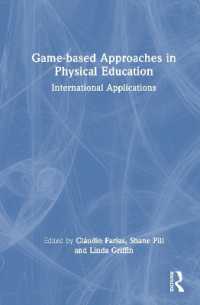- ホーム
- > 洋書
- > 英文書
- > Science / Mathematics
Full Description
This volume argues that concepts from the theory of computation—including information theory, formal languages, and discrete structures—might provide novel paths towards a solution to the problem of quantum gravity. By combining elements of physics with computer science and mathematics, the volume proposes to transform the foundations of spacetime physics and bring it into the digital age.
In recent years, it has become increasingly apparent a new theoretical framework will be needed to solve the problem of quantum gravity. This kind of framework— sometimes referred to as "pregeometry" or even "prephysics"—goes beyond conventional mathematical conceptions of space, time, and matter, seeking their building blocks in more fundamental elements. The essays in this volume explore this approach from a variety of perspectives, including physics-based, mathematical, computational, as well as philosophical. The new formal frameworks needed to discuss such approaches have their roots in homotopy type theory, formal language theory, and higher category theory; the computational perspective is informed by connections between pregeometric structures to formal proofs and programs; and the new philosophical fulcrum supporting these new avenues is inspired in constructivism of meta-structures. By probing at a level of structure beneath the ordinary structures used in general relativity and quantum mechanics, this volume seeks to find new ways of showing how these higher-order structures can be constructed from the deeper elements.
Quantum Gravity and Computation is an essential resource for scholars and graduate students interested in the philosophy of physics, quantum mechanics, and computational science.
Contents
Part 1: Scene Setting 1. Open Questions at the Quantum Frontier Part 2: Locality, Non-locality, Observers, and Agents 2. Spacetime Events from the Inside Out 3. On the Role of Locality in the Bose-Marletto-Vedral Effect 4. Towards a Generalized Theory of Observers Part 3: Computational Languages for Physics 5. Topological QBits in Flux-Quantized Super-Gravity 6. Linear Homotopy Type Theory: A Computational Language for Quantum Physics 7. Pregeometry, Formal Language and Constructivist Foundations of Physics 8. Quantum Information Elements in Quantum Gravity States and Processes Part 4: Conceptual Issues for Computational Foundations 9. Do Simples Exist? The Light Shed by Computation on an Ancient Question 10. On the Nature of Time 11. The Prototime Interpretation of Quantum Mechanics 12. Ruliology: Linking Computation, Observers and Physical Law Part 5: Lattice and Hybrid Theories 13. Nonperturbative Quantum Gravity, Unlocked Through Computation 14. Structure and Statistical Properties of the Semiclassical Einstein Equations







